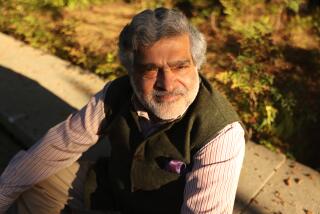The Magnificent, Puzzling Self-Creations of Gandhi
- Share via
Gandhi’s presence in the 20th century, a century that perfected the arts of extermination, is weirdly arresting. His life seems peculiarly unhoused in the violent landscape of his times. How, by what twist of historical fate, did this frail, ungainly man with teapot ears, whose figure wrapped in handspun cloth evoked a faded archetypal memory of saintliness, wander into the modern world; and how, for a time, did he electrify it? What was he doing there, and what can the trace of his presence mean to us today, balanced precariously as we are on the edge of a fearful period--a period of violence, of retaliation and counter-retaliation, the proverbial eye for an eye?
More than 50 years after his violent death at the hands of a Hindu fanatic in 1948, Gandhi has become a symbol and a myth. Yet we are still far from taking the measure of his enigmatic and remarkable personality. Confronted by the vast corpus of his writings and speeches (his collected works make up a 100-volume monument), interpreters continue to quarrel, seeing him variously as a spiritual paragon, a wily politician, a psychological and anthropological curiosity, an inventor of political techniques of nonviolence and civil disobedience or as a critic of modernity.
In trying to make sense of him, perhaps the safest clue is to be found in his famous plea: “My writings should be cremated with my body. What I have done will endure, not what I have said or written.” Fortunately for us, the traces of what he did have been repeatedly and fascinatingly captured in that distinctive 20th century medium, half documentary-half art: photography. It is hard to think of a public figure more photographed than Gandhi --as if even during his lifetime people recognized that the only way to convey something of his force was through physical images of his presence.
We have now in one volume a magnificent, luminous collection of photographs of Gandhi, assembled by Peter Rhe at his Berlin archive.
The most striking are drawn from private and unseen collections (many come from the albums of Kanu Gandhi, the Mahatma’s great nephew): images that are intimate, unusual and beautiful. We see through them the alteration in Gandhi’s physical presence. Early on, in South Africa, he appears taut and buttoned up, in suit and waistcoat, wing collar and tie; then, after he set up his first experiment in communal life, Tolstoy farm, we see him dapper in white shirt and trousers and sandals--the look of a European vegetarian crank. We see him after his return to India in 1915, abandoning Western clothes for dhoti, shawl and cap; and then, after 1921, he acquires the look we associate with him: the shaven head and naked torso (we see him thus at a garden party in 1924, conspicuous among the suits and plumes). He has by this point become his own icon.
Yet even when he is easily recognizable, there are surprises: Gandhi on bicycle, his shawl flapping like the gown of some eccentric don; upright in an armchair on the beach; on the telephone, on a weighing scale; peering through a microscope. Some of the most striking photographs, though, are not of him alone; they show him amid a group or show people watching him or waiting for him. There is, for instance, an eerie photo of the crowd at Durban harbor in 1897, waiting for Gandhi to disembark from a ship arrived from India. They were there to attack him, hoping to lynch him. The photographs reveal, too, Gandhi’s transition from mere politician and leader to celebrity. That status was confirmed during his 1931 visit to England. Here are the paparazzi, trilbys and flashbulbs in place, lined up and waiting for him to appear; there, Charlie Chaplin leaning out of a window to catch an advance glimpse of him; fascist youth smiling at him; and the famous photograph of him with the female textile workers of Barnsley, Lancashire.
Such photographs were of course carefully posed and directed, and what this book helps to demonstrate is how artful a choreographer of his own doings Gandhi was. He seemed to know from an early age that he wanted to organize the haphazard trivia of his daily actions into formal order, to give them a shape and meaning. George Orwell, otherwise temperamentally distant from Gandhi, saw exactly the tensed, pageant-like character of Gandhi’s life, its status as a theatrical parable, when he observed of Gandhi that “his whole life was a sort of pilgrimage in which every act was significant.”
What gave every act its significance was its place in a larger story. Indeed, the most subversive skill of this famously unarmed rebel was his ability to tell stories, stories that came entirely to redefine how people perceived themselves and what they believed they could and could not do.
Nowhere did Gandhi deploy this skill to more powerful effect than when it came to his own life: It enabled him not merely to turn his life into a story but to live it as a story. That skill is clearly manifest in Gandhi’s “An Autobiography or, the Story of My Experiments with Truth,” a magnificent, puzzling, strenuous act of self-creation which describes--as it enacts--the metamorphosis of a fearful, unsuccessful provincial lawyer into a leader who dominated India’s politics for almost four decades and who took on and defeated the British imperial state.
What drove this transformation was Gandhi’s capacity for self-creation or, as he termed it, his fascination with “experiments” in living. Experiment is the operative mode of “An Autobiography,” the narrative cause and impulse. In his quest for an ethical life, Gandhi conducted experiments in dancing and in running a household, in education, washing and laundry, in healing and medicine, in hygiene, politics and dietetics, in fasting and in Earth and water treatment, in friendship, in communal living and, of course, in truth.
Through experiment, Gandhi came to confront and finally face down his “fear and trembling,” a condition that runs like a leitmotif through the entire text. In so much of his autobiography, Gandhi’s sense of physical fear is palpable: at the prospect of speaking--at school, on board ship, before the courts of law, even when, already a political personage, he was called to address the Indian National Congress. We feel too his fear at nightfall and darkness; when he has to mix with the Indian elite; when trying to make his career as lawyer; and, perhaps most painfully, in the trivial everyday routines of life. Buying a train ticket, traveling, puzzling over how to dress himself, even when walking down a street, all are liable to induce terror in Gandhi.
Gandhi’s narrative voice sometimes seems to affect a jaunty, almost Pollyanna-like tone. Yet this is deceptive. For Gandhi’s experience is that of a man cast into a world in which he has to wage a constant battle to steady himself: a world where both the traditional, with its superstitions and rituals, and the modern, with its choices framed by colonial power, appear intimidating.
To write an autobiography, Gandhi confessed to his readers, was to indulge in something of an unnatural practice, one that was “peculiar to the West.” Yet his use of the form marks a landmark in non-Western, and specifically Indian, literary invention. He used it to create, in the Indian imagination, the domains of public and private: He reminds his readers that for a “history” of his public work and life, they should turn to “Satyagraha in South Africa”; here, in the autobiography, they will find only the details of his personal and private life.
Yet no sooner were these spheres demarcated than Gandhi was busily blurring and commingling them. His use of the genre of autobiography was itself an instance of his ability to seize upon categories from the Western repertoire and to translate them and bend them to his own purposes, allowing him to live and recount his own non-Western--and distinctively modern--Indian life.
Human personality was, for Gandhi, not pre-given and static. It was not decisively shaped by either nature or culture: instinctual fear or social prejudice, each was conquerable. Because human personality was susceptible to influence and infinitely revisable, so too definitions--of values and ideals--had to keep an open-ended character: Meanings were not stipulative but needed to be worked out in the crucible of practice.
In his own life, and in his recounting of it, he bore witness to this. The persona adopted in the “Autobiography” is not that of a saintly, prophetic individual preaching his message; rather, it is that of a kind of Everyman (one of Gandhi’s favorite books was John Bunyan’s “The Pilgrim’s Progress”), stumbling painfully out from darkness and error toward the light of truth. Gandhi charts an artisanal picture of the moral self, one that enables the crafting of ethics at once personal and universal in the midst of a bewildering world.
That ethics was far removed from any Hindu view of a spiritual life as one that required renunciation of the world. Gandhi explained the relationship between his spiritual quest, his pursuit of truth by means of nonviolence, and his involvement in public life:
“To see the universal and all-pervading Spirit of Truth face to face one must be able to love the meanest of creation as oneself. And a man who aspires after that cannot afford to keep out of any field of life. That is why my devotion to Truth has drawn me into the field of politics; and I can say without the slightest hesitation, and yet in all humility, that those who say that religion has nothing to do with politics do not know what religion means.”
It is an important formulation, one which makes no sense if read either solely in terms of the grammar of traditional Hinduism or the lexicon of modern politics. By putting it this way, Gandhi steers our attention to the profound unconventionality of his ethical sense: its existence as a product of radical, original and deeply personal choice. The necessity of choice and the discovery--by the means of experience and constant experiment--of the capacity of judgment that allows right choices to be made: the core drama of Gandhi’s life. His is a very modern drama, and Gandhi’s was a very modern life, perhaps most of all in its judgment that there was more to life than just being modern.
More to Read
Sign up for our Book Club newsletter
Get the latest news, events and more from the Los Angeles Times Book Club, and help us get L.A. reading and talking.
You may occasionally receive promotional content from the Los Angeles Times.










